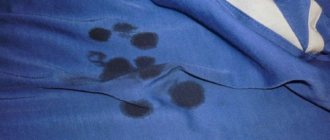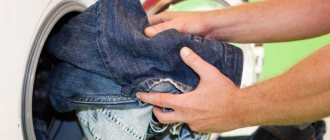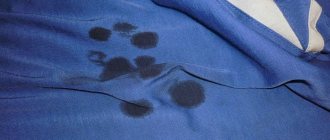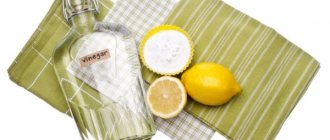In some cases, improvised and special means will help cope with the situation. Moreover, it is possible to clean even such a complex surface as concrete.
We'll tell you in this article how to remove machine oil stains from clothes, asphalt, concrete, and paving slabs.
Where to begin?
Most often, clothes suffer from oil stains. An accidental mark can lead to the fact that an otherwise good piece of clothing will simply have to be thrown away. To prevent this from happening, it is advisable to begin removing traces of technical fluids as soon as possible.
It is important to adhere to two main recommendations:
- Localize where engine oil gets on the surface, preventing it from spreading over a larger area.
- Prevent oil from absorbing into the material. To do this, use preparations that can absorb the spilled product.
It is recommended to sprinkle a fresh stain on top as quickly as possible:
- salt,
- talc,
- chalk,
- starch or other powder that will slow down the absorption of oil into the surface.
After the grease has been absorbed, the powder is collected and work begins to remove traces of spilled engine oil.
It is recommended to use absorbent products in all cases where oil has been spilled. Regardless of the type of surface material.
We recommend
DOCKER MAZBIT TURBO is a concentrated industrial cleaner for all types of heavy contaminants. Designed for effective quick cleaning of any surfaces: parts, components, mechanisms, plastics, general construction materials (concrete, stone, tiles, asphalt) from various oil-fat and petroleum contaminants, fuels and lubricants, lubricants, graphite, fuel oil, oil. Has no smell. No acid.
More details
How to remove machine oil from asphalt How to remove oil from concrete How to remove machine oil from a concrete floor
How to remove using traditional methods?
You can try to remove traces left by machine oil using improvised means.
Laundry soap
Soap is the most gentle way to remove stains, but a good result is only possible if the stain is fresh. Procedure:
- rub the affected area with soap;
- put the item aside for 3 hours;
- rub the treated area intensively with a brush using hot water;
- wash in the usual way.
Re-processing may be necessary.
Dishwashing gel
A gel containing fat-soluble components can help remove stains, but only if a little time has passed.
Application procedure:
- Apply the product generously so that the gel covers the entire stained area and saturates the fabric.
- Leave for at least 2-3 hours.
- Rub with a brush.
- Rinse.
- Wash the product.
Toothpaste
For fresh stains, toothpaste can be used. The product is applied generously to the area, rubbed, and after a couple of hours washed in warm water.
Toothpaste will not cope with old traces of oil , but it can discolor the material at the site of application if the exposure was long enough.
Ammonia
Ammonia is often used as a solvent. Before use, the drug must be diluted with warm water in a 1:1 ratio. The material is actively moistened with the solution and left to act for 15-30 minutes. After which they wash it.
It is possible to remove machine oil stains in this way only if they are fresh.
Ironing
You can try to eliminate the oil by heating the affected tissue. For these purposes, you will need paper napkins with high absorbency.
Procedure:
- place the napkins on both sides of the area of contamination;
- iron the fabric through several napkins;
- Continue the process, replacing soiled napkins with clean ones as necessary.
Heating fabric stained with machine oil may be accompanied by the release of a specific unpleasant odor.
Petrol
Refined gasoline can be used as a solvent. Baking soda and liquid soap are also useful for removing stains.
Procedure:
Combine liquid soap and gasoline in equal proportions.- Stir.
- Apply the composition to the stain.
- Leave to act for 1-1.5 hours.
- Rinse off.
- Sprinkle baking soda on the contaminated area.
- Leave for 10-15 minutes.
- Rinse off.
- Wash.
Kerosene or acetone can be used instead of gasoline.
How to remove machine oil from leather and fur clothes?
You can wash off oil from fur pile using a combination of simple ingredients. Flour is used first. It is supposed to be sprinkled on the area of contamination. Then you will need a soap solution. To prepare it, you need a share of laundry soap equal to one quarter of a whole bar. And also warm water (about 2 liters). You will have to dissolve the soap in it.
Then use a spray bottle to spray the floured area. The fur will be covered with a layer of special dough, which must be rubbed into the fur. When the product dries, all that remains is to clean the clothes with a brush. Depending on how dirty the item is, re-treatment may be necessary. The leather product will have to be covered with a paste of starch and water.
Leave it for five minutes. Then wipe the area of the oil stain with a cotton swab dipped in gasoline. Its remnants will then help remove the bread crumb.
How to remove with special preparations?
Even such complex marks that machine oil leaves on clothes can be removed. For these purposes, stain removers are used that are active against greasy marks from technical fluids.
Dr. Beckmann
The stain remover made in Germany is available in liquid form in small packages. The product is suitable for removing marks left on fabric:
- machine lubricant,
- oil,
- bitumen.
The drug can be used to treat things of adults and children.
For the composition to work, the stain is well wetted, covered, and the product is allowed to lie. In this case, the surface of the fabric should not dry out. As a result of processing, machine oil dissolves and can be removed with tampons and napkins. The area of material is wiped with a rag. After the oil is removed, the textiles are washed.
The product is not suitable for treating carpeting and leather items . The average price is from 200 rubles per bottle.
Astonish Oxy Active Plus
The drug, produced in Great Britain, is available in concentrated form. The product contains no phosphates. The powder can be used to wash clothes for children and adults made from various types of fabrics.
Astonish powder can be used to remove difficult and old stains. In addition to clothes, the stain remover helps clean:
- furniture upholstery,
- floor and wall tiles,
- carpets and other surfaces.
The product comes with a measuring spoon, which makes dosing easier. Price – from 150 rubles per 0.5 kg package.
Liqui Moly Auto-Innenraum-Reinger
Automotive cosmetics - car interior cleaners - work well with machine oil on fabrics and other surfaces. The drug TM Liqui Moly is available in liquid form in bottles with a sprayer. It removes traces of machine oil well and refreshes the material.
To clean the fabric from stains, the product is sprayed onto the problem area, and this action is repeated if necessary . During the cleaning process, do not allow the liquid to dry on the material. Price – from 800 rubles.
Dry cleaning
Stains from fuel oil or motor oil are very difficult to remove. If none of the methods helps remove stains or you have doubts that you can save your favorite item on your own, you can use the help of specialists.
Dry cleaning is a reliable way to get rid of traces of machine oil on clothes, which does not require any effort from you. Things made of any material will be provided with qualified assistance without the risk of spoiling it.
How to clean different types of fabrics?
When starting to remove an oil stain, you need to consider the type of clothing and type of material. Both improvised and special means can be used.
Cotton, linen
To remove oil from natural fabrics, you can use simple folk recipes. Even dishwashing gel gives good results if you use it while the stain is fresh.
Without pre-treating the stained area, items should not be washed in hot water. Otherwise, the stain will be very difficult to remove.
Jeans
Denim material has a high density of fiber weave. Oil that gets on jeans is quickly absorbed and difficult to remove. To treat such fabric, it is better not to use soap or dish gel, but rather more aggressive solutions. For example, based on acetone or gasoline. It is recommended to treat the material with solutions from the reverse side.
Suede
You will have to remove oil from suede in several stages, working gradually.
It is possible to use any of the methods that does not stain or discolor the material, and also does not spoil the texture of the suede. This could be ammonia or gasoline .
The solvent should be used sparingly, without spreading the stain over the surface of the material. At the end of the process, it is better to wash off the remnants of the products that were used to remove oil with a soap solution, and treat the suede with a special product.
Outerwear
To remove oil from jackets and other things, gasoline, laundry soap, dishwashing gel and other available products can be used.
Treatment should begin by removing excess oil and preventing the grease from spreading to the interior and lining. In difficult cases, you will have to prop up the lining in order to have access to the problem area from both sides.
It can be very difficult to clean up membrane and other things after oil stains, and the result is not guaranteed. An alternative approach is to dry clean your outerwear.
Leather
Any stains from natural leather should be removed as carefully as possible, avoiding intense exposure. To remove stains , soap, gasoline, and dishwashing gel can be used . After finishing the treatment, the skin must be treated with a special product.
This video will show you how to remove machine oil stains from clothes:
Combination of fabric and stain remover
Each type of fabric reacts to abrasive substances in its own way, so before applying the product to its surface, it is necessary to take into account the composition of the fabric and the type of coloring.
- Due to the natural fibers contained in wool and silk fabrics, which are susceptible to the dangerous effects of chemical ingredients in stain removers, experts recommend the use of gel-based products. They gently remove dirt without having an aggressive effect on the structure and color of the fabric. Therefore, the first place to remove areas with an oily coating should be dry cleaning.
- For synthetic fibers, the best option is to use oxygen stain removers.
- Cotton and linen items can be treated with products with increased abrasive properties.
Depending on the color of the canvas, certain methods of cleaning them from machine oil blots are also used.
If paint is applied to the fabric, then a preliminary test of using any stain removers and folk remedies is strictly necessary. Otherwise, an application that has not been tested in advance may lead to a negative result in the form of a roughened or discolored area on the clothing. One of the safest methods for removing an oily substance is to sequentially apply turpentine and soda to the surface of the material, followed by rubbing the stain.
On white cotton and linen fabrics, stain removers with chlorine and washing with bleach can be used. You can first carry out the procedure of dissolving the stain using an iron, as described above. Refined gasoline, solvents, acetone, car shampoos, and anti-clog liquids have also shown high effectiveness on this type of fabric.
Such methods will not work on thin material, but will only make the situation worse. In such a situation, experts recommend using oxygen stain removers with pre-treatment of the contaminated areas with a mixture of mustard powder and water. It is applied to the stain, lightly rubbed and washed off with running water. Next, the standard washing procedure is carried out.
Features of removal from paving slabs, concrete, paving stones and asphalt
Removing technical fluids from concrete, tiles and asphalt not only allows you to maintain the aesthetics of the area around your home and garage.
Oil remaining on the coating:
- reduces its strength;
- worsens the fire safety level of the garage;
- violates the environmental friendliness of the space.
Machine oil spilled on asphalt, tiles or concrete surfaces is very difficult to clean up. This is due to the fact that high molecular weight resins in used oil easily penetrate porous surfaces.
Methods for dealing with oil drips can be divided into the following groups:
Mechanical cleaning . Brushes, scrapers, grinders and other devices are used for it.- Dry and wet cleaning . In this case, the stain is covered with sand, sawdust or soda. After sweeping, most of the oil is removed. The cleaning is completed by washing with targeted water under pressure.
- Chemical processing . Solvents are used for this.
In most cases, to achieve optimal results, it is necessary to use an integrated approach that combines several methods of influence.
This video will show you how to remove machine oil stains from paving slabs and concrete:
Instructions for removing oil stains
If the problem has just appeared on clothes, then you can get rid of it using simple technology. It is necessary to place a small piece of thick paper on the other part of the stain so that the stain does not bleed onto the other part.
Next, take a simple dishwashing detergent, mix it with warm water and apply it to the stain using a spray. It will begin to decompose under the influence of alkali and can be easily washed off later.
If the problem has been started, it is recommended that you read the tips below.
What not to do?
When removing engine oil, it is important to avoid these common mistakes:
- Start removing stains over time. If a lot of time has passed since the oil hit a porous surface with good absorbency, and the composition has been absorbed and fixed, it will be extremely difficult and slow to remove it completely.
- Technical oil is a difficult substance to remove. To cope with it, chemical manufacturers offer agents that are aggressive in their effects. In this case, there is a possibility of damage to the material. To prevent this from happening, any solvent must first be tested on an inconspicuous area.
- Intense friction of fabric, especially without the use of solvent. With this effect, the stain can occupy an even larger area and penetrate deeper into the material.
Precautionary measures
All products used to remove oil stains are chemically aggressive and can cause significant harm to human health. Therefore, when using them, it is necessary to observe basic and necessary safety measures.
Mandatory conditions for working with such substances are:
- availability of rubber gloves;
- fabric mask;
- well-ventilated area;
- a supply of water for treating the skin of the hands and face in case of accidental contact with the substance.
Recommendations
For more efficient work, it is recommended to adhere to the following tips:
Gentle machine oil removers may have little or no effect on old stains.- Before using the solvent, you need to study the instructions for it.
- Older stains may need to be treated several times. And even in this case, the result may not be the best.
- Most engine oil solvents have an aggressive composition. In order not to spoil the item, it is recommended to test it on an inconspicuous area before using the product for the first time.
- Even after removing the stain, a specific technical aroma may remain on the clothes for some time. To completely eliminate it, the item needs to be well ventilated.
- Worn fabrics may not withstand intensive cleaning. If an item has a significant degree of wear and tear, it will simply have to be thrown away.
The result of removing an oil stain largely depends on the thickness of the composition and brand of the product, as well as how long ago the stain was placed.
If you are interested in how to remove vegetable and machine oil stains from various surfaces, take a look at this section.
Basic rules for removing oil stains
Machine oil is a general concept that includes not only a light-colored oily liquid for lubricating door hinges, bicycle chains or sewing machine mechanisms, but also darker and thicker oil for automobile engines (motor oil), various lubricants (solid and liquid) .
There are three types of engine oils:
- mineral - based on oil with subsequent distillation and purification;
- synthetic – based on synthetic hydrocarbons obtained from petroleum products;
- semi-synthetic – based on no more than 20% synthetic components.
Thus, any oil consists of petroleum products and has high chemical stability, being firmly embedded in the fibers of the fabric. That is why it is very difficult to remove - you need to use solvents or strong alkalis.
If an oil-oil stain appears on your clothing, then in order to remove it without leaving a trace, you need to follow several rules.
Start removing contamination as soon as possible, preferably in the first minutes. Only fresh oil stains can be removed with grease-dissolving products.
To prevent the stain from spreading over a large area, whenever possible, sprinkle salt, soda, crushed chalk, and starch on it. These powders have absorbent properties and will quickly absorb most of the oil. You can increase their effectiveness by preheating them to 50-600C in a microwave oven or in a frying pan.
Do not wash or soak things in hot water if oily stains have not been previously treated with adsorbents - the size of the contaminated area may increase.
Before treatment by any method, you should place a support under the contaminated area - a towel folded several times. This way, after dissolution, the oil will not contaminate the clean surface of the product.
When removing old oil stains with solvents from delicate fabrics or painted items, you should first check how they will affect the material and paint on an inconspicuous area of the product, and only then apply the product.
When working with solvents, you should be careful: work with strong rubber gloves, a respirator, and safety glasses. In addition, it is important to consider that these products are highly flammable, so you need to clean things away from open flames.
We use what is at hand
As with any other stain, the rule of thumb for motor oil stains is that the sooner you start cleaning, the more likely you are to save your clothes.
You need to try to solve the issue rationally by studying this problem and the possibility of solving it not in a dry cleaner, but at home.
And it is precisely in relation to “fresh” stains that the following remedies work very effectively.
Toothpaste
Every home has toothpaste or powder. You need to apply a little product to a cotton swab (for greater effectiveness, you can add a little salt or soda), saturate the stained area well with it and leave until completely dry.
After the mixture has dried, take a clean brush (either a toothbrush or a clothes brush) and brush the substance off your clothes, and put the item in the wash as usual. By the way, instead of tooth powder, you can use ordinary chalk.
Oil stains on clothes
Absorbs fresh machine oil well.
Mustard powder
Sprinkle dry mustard on the stained area of clothing and add a little water to make a thick paste. Rub the pulp onto the surface with a brush.
Then lather, scrub and rinse in cool water. Then apply mustard again, lather again and rinse. Repeat the procedure several times until the stain disappears completely. After this, wash the item.
Mustard will help remove machine oil from delicate, thin fabrics.
Kerosene
Apply it to the oil stain, leave it for 10 minutes and blot the stained area with napkins. Then wash the item in the washing machine.
After such treatment, stains are inevitable, so the item will also have to be washed. Moreover, you need to wash it exclusively in hot water.
Chalk and iron
A strange combination at first glance gives excellent results in the fight against oil stains. This method will not miraculously remove the stain, but it will make it more susceptible to subsequent treatment.
The chalk is crushed, a clean absorbent cloth is placed under the oil stain, the stain is lightly sprinkled with chalk and covered with a clean cloth, and the tip of a hot iron is “walked” over the stain. After this, you can start soaking, washing and washing in the washing machine.
Any oil softens when exposed to high temperatures and is absorbed into other tissues.
Changing the oil in automatic transmission Peugeot 307
The chalk particles will absorb the machine oil and can then be gently shaken off the cleaned cloth.
Laundry soap
The most effective in fighting stains is 72% soap. The pH factor of such a bar reaches 12, while concentrated alkalis have a value greater than 13. That is why laundry soap is an ideal remedy for combating various stains.
To begin with, the stain should be washed off as much as possible with hot water, then soaped with laundry soap and rubbed well. After some time, rinse and repeat the procedure.
A simple way is to use laundry soap.
Sodium hydroxide
This, as they say, is heavy artillery. It is used in cases where all other methods and means have failed. The work is carried out very carefully. Make sure there are no children in the house during the procedures. All manipulations must be carried out with latex gloves.
The work is carried out in several stages: first, dry alkali flakes are diluted in cold water until a mushy mixture is obtained.
After the flakes have completely dissolved, apply the product to an inconspicuous area of the item to check the activity. After applying the mixture to the stained area, rub it and then rinse it off. After this, rinse well and treat with a solution of water and vinegar. Rinse in clean water and dry as usual.
This is a last resort if other methods have proven ineffective and if the engine oil is particularly thick and corrosive.
How to remove an oil stain from denim
It should be noted that jeans suffer from car oil more often than other clothes. Every second man wears jeans, and women are not far behind in this regard. They are convenient to ride in the car, so it’s no wonder one day you’ll put a stain in the most visible place.
- For processing, you will need a brush, since denim fabric is dense.
- Take a solvent and moisten the stain with it, apply washing powder as a second layer, and water as a third layer.
- Next, start brushing the fabric and apply force to it.
- You will see the oil stain gradually disappear. This is followed by mandatory washing and thorough rinsing.
To treat jeans, ammonia with turpentine can help, the recipe for preparing the mixture, the processing process is described above, as well as a specialized spray.
Fresh spots
It is much easier to solve the problem if the stain has just been planted and you quickly begin to eliminate it. When oil gets on clothes, it is very important to minimize the time it remains there, that is, not to allow it to be deeply absorbed. Otherwise it will be much more difficult to wash.
In the first minutes, and sometimes even seconds, it is recommended to pour any absorbent powders and products onto the stain. This should include:
- chalk;
- dentifrice;
- dry mustard in powder form;
- salt;
- starch, etc.
All these products have good absorbent properties. Therefore, when applied, they will begin to take oil and other similar liquids from the fabric.
If the stain is very fresh and the absorption process has just begun, then blot the clothing with a dry cloth, cotton pad or toilet paper. At this stage, the task is to prevent the oil that still remains on the surface of the product from being absorbed.
When you have dampened the cloth with paper and also poured in the powder, remove the remaining product. Then you can start washing. Moreover, here you should use water at the maximum temperature that the fabric can withstand. The tags usually indicate at what temperature a particular product should be washed.
After soaking the material in water, carefully go over the stain with a piece of laundry soap. Wash it off with a soft brush or sponge. After this, it is important to pour one of the powders listed above again, let the remaining oil be absorbed, soak in water again and treat with laundry soap. If a large amount of oil gets on your clothes, then it is better to repeat this procedure several times.
The job is completed by sending the product to the washing machine. Moreover, it is recommended to wash in the mode intended specifically for this clothing. It is not recommended to add other clothes to the drum that do not have any traces of oil on them.
But there are situations when there is no chalk nearby, and some powders from the list are also missing. I definitely have toothpaste at home. You should take advantage of its properties. But it is important that the paste is plain white, without dyes. The paste should be applied to the stain, smeared a little with your fingers or a cotton pad, without going beyond the stain, and left to dry. Since the paste has good adsorbing properties, it copes well with fresh oil stains. When the paste dries, you need to moisten it and gently brush it with a toothbrush. Then you send the clothes to the wash.
You should not completely rely on modern powders and other similar washing products. In rare cases, they will cope with contamination in the form of motor oil on their own. Therefore, it is recommended to first get rid of the bulk of the lubricant using the indicated methods, and then trust the washing machine and special synthetic products. With this combination of methods, the chances of success are much higher.
In some cases, WD40 aerosol is used
Old stains
There is a category of people who can plant some kind of stain, and only after a while remember about it. Here we can no longer talk about any express solutions that are relevant for fresh stains. You have to look for ways on how and with what you can wash stubborn machine oil from your clothes.
In general, even an old stain can be washed off. Although the chances of success are not as great as in the case of fresh traces of oil. But it’s still worth trying to wash it off.
The only question is what exactly you can use to wash absorbed and dried motor oil from your clothes. Experienced specialists, ordinary motorists and experienced housewives give some practical advice:
- You need to start with the least aggressive, but still quite effective means. Therefore, it is first recommended to use good quality dishwashing liquids. They perform an excellent degreasing function, which is important for traces of machine oil. The product is simply poured onto the stain, without mixing with water and rubbing in thoroughly. You just need to spread the liquid and let it sit for about 20 minutes. Then the residues are removed with paper towels. Only then do the clothes go into regular washing;
- Also, for old stains, you can use solvent, kerosene or universal WD40, which is used literally everywhere. One of the substances is applied to the stain. Using a soft cloth, begin wiping the product from the edge to the center of the stain. Afterwards, the maximum permissible hot water is taken, and the clothes are washed with laundry soap;
- A combination of solvent and bleach powder also works well on old motor oil stains. This recipe is most suitable for white clothes. First, the stain is moistened with a solvent, the residue is removed with a napkin, and powder is poured on top. You should also sprinkle the powder with a little water to dissolve it. Let the material sit for a few minutes and remove any remaining powder with a soft brush. There is no need to press hard or smear the stain. If the oil is not completely gone, repeat the procedure again;
- Refined gasoline is considered an excellent solution. Yes, you can also take regular gasoline, which is filled at gas stations. But only the degree of its effectiveness is much lower. You should take a couple of cloth napkins and wet them. One is placed under the stain, and the second on top of the stain. Let it brew for about 30-40 minutes. If the stain does not completely go away, you can repeat the procedure again. Then wash normally;
- The most powerful remedy is considered to be a combination of ammonia and turpentine. These substances must be mixed in different proportions. The application scheme is similar to using a solvent.
Stains on outerwear
Many motorists are interested in how to properly remove oil from their outerwear. In this regard, down jackets are considered the most problematic.
It is important to try to prevent the formation of abrasions. Otherwise, you will ruin the appearance of the product, and you are unlikely to wear it further. Color preservation also plays an important role in proper washing. To begin with, avoid prolonged contact of the detergent with the fabric.
If motor oil gets on your outerwear, you can try to get rid of it in several ways and means.
- Gasoline, turpentine or kerosene. All these liquids have approximately the same effectiveness. Therefore, take what is at hand or is easier to get without spending a lot of time searching. Fill the contaminated area with a small amount of this liquid and let the outerwear sit for about 10-15 minutes. After this, take laundry soap and use it to remove the stain. Only after these manipulations send the product to the washing machine;
- An alternative to the listed means is a regular solvent. Just under no circumstances should you pour solvent into your jacket, since the product is incredibly aggressive. Wet a regular cotton pad a little and start soaking the dirt. Try not to rub the oil beyond the existing stain. Change the cotton pad periodically so that it absorbs dirt;
- Use products like Pemolux. Quite effective and easily accessible. The principle of washing is to treat the jacket with a small amount of the substance and leave for 40-60 minutes. After this, mandatory hand washing or loading into the washing machine. Here, start from the requirements of the outerwear itself.
Since all of these products have a high degree of aggressiveness, but at the same time can effectively deal with oil stains, their use should be approached with extreme caution. Otherwise, you risk not only not getting rid of traces of oil, but also completely ruining the product.











